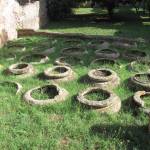 The exceptionally well-preserved and extensively excavated harbour of Rome,the city of Ostia (2km2, one third of the city) was a key naval base, and the emporium of the empire. She experienced an economic boom, and rapidly became a place where people and ideas from the entire Mediterranean came together. Its monuments, houses, shops, factories, shrines and cemeteries reveal architectural and epigraphic traces of cultural interaction, which can also be seen in the wider spatial organisation of the city.
The exceptionally well-preserved and extensively excavated harbour of Rome,the city of Ostia (2km2, one third of the city) was a key naval base, and the emporium of the empire. She experienced an economic boom, and rapidly became a place where people and ideas from the entire Mediterranean came together. Its monuments, houses, shops, factories, shrines and cemeteries reveal architectural and epigraphic traces of cultural interaction, which can also be seen in the wider spatial organisation of the city.
The project Segregated or Integrated? – Living and Dying in the harbour city of Ostia, 300 BCE – 700 CE investigates how established and incoming cultures interacted within the built environment, material and literary culture, over a millennium, in terms of their political, social, and religious life, both in the local community and in the central hub of Mediterranean travel.
Different cultures, ethnicities and religions from across the Mediterranean interacted in a port environment that was especially sensitive to changes in the wider world. The well-preserved urban landscape of Ostia provides a unique opportunity for an enquiry into a millennium of pre-modern cultural identity and addresses a modern issue: how do migrating groups change an urban society?
On what basis did the people in Ostia built their identity? How did the ancient harbour city of Rome cope with the immigration? Did Ostia constitute a middle ground where several identities could co-exist?
- How were local identities constructed and transformed in a multicultural and cosmopolitan setting?
- How did the arrival of incomers affect urban development, public building, urban rituals and social display?
- How were global ethno-religious practices embedded in the daily life of local neighbourhoods?
We seek to answer these questions through epigraphy, spatial analysis, topographical survey, research of human osteology, literary and cultural research, integrating the existing survey and excavation results of team members already active here.
The project adds a new, much needed, research perspective to the already existing and currently conducted studies in Ostia by approaching the city in its entirety from a cultural and social perspective, which allows us to re-examine the lives and fates of Ostia’s inhabitants with new objectives and methodologies. Together, in our publications, database and exhibition, we will provide an interdisciplinary synthesis on Roman urban identities, and showcase this great example of the ancient experience of cultural encounters.
